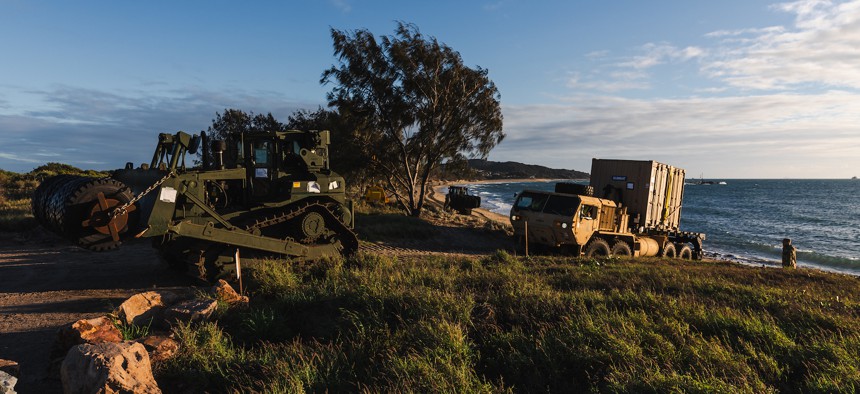SAM SKOVE

Logistics moved to center stage in a giant Army exercise in Australia this summer, a nod to the Pacific region’s vast distances and rough weather. But another age-old hurdle also popped up: government regulations.
“Probably our most significant obstacle was the agricultural inspections” in Australia, said Col. Daniel Duncan, assistant chief of the logistics section of I Corps, which plays a major role in Army operations in the Pacific. “They are very, very stringent.”
From July 22 to Aug. 4, U.S. forces participated in the largest-ever iteration of the Australia-based Talisman Sabre exercise, with Duncan’s soldiers helping provide logistics to more than 34,000 people from 13 participating nations.
Duncan said this year’s iteration of the exercise saw a new focus on logistics.
“This is probably the largest in scale that anybody has seen in a long time,” he said in an interview. “It’s a significant shift.”
Navy and Army ship transports started their journey to the exercise thousands of miles away in the United States before winding their way to various Pacific bases and finally arriving in Australia.
Ships involved included two Navy Large, Medium-Speed Roll-on/Roll-off class vessels, Duncan said, as well as Army watercraft.
Once in Australia, the exercise’s operations spread more than 1,500 miles from Darwin on the Timor Sea to Gladstone Port on the Pacific.
“If we were to do a similar exercise in the United States,” Duncan said, “You’re talking about an exercise that spans from about Los Angeles to Seattle.”
Duncan’s unit was responsible for ferrying around 1,200 pieces of equipment, including tanks, trucks, and other vehicles, some of which stayed in Australia for future use.
The exercise also saw the Army’s first-ever use of a floating pier in an Australian exercise. The pier, which allows the Army to offload vehicles to damaged ports, is 24 feet wide and stretches over 360 feet. The Army normally only practices using the pier once a year.
But bad weather prevented the Army from using the platform to ferry tanks onto the beach, Duncan said, citing high winds that he was told were far higher than normal.
Some problems were merely a matter of practice, such as agricultural inspections, which Duncan said was fixed thanks to support from Australia and a permanently deployed U.S. liaison group.
Other problems are more enduring, such as outdated ships which Duncan said “gradually put things behind schedule.”
The U.S. Department of Transportation announced in March that it would acquire two transport vessels to replace aging ones.
“I think it has a lot more attention now,” said Duncan, who sounded an optimistic note, although some Congress have said the military is neglecting sea transport.
On the plus side, Duncan said that the Army faced no significant problems when drawing material from prepositioned stocks across the Pacific as part of the exercise.
The Army has previously hailed the prepositioned stock program as key to a snap deployment to Europe last year, although it has also found maintenance problems, most notably misfiring howitzers stored in the Middle East.
This year’s exercise included virtual simulations of logistics, with an emphasis on spreading out logistic points in order to present smaller targets to accurate enemy missiles.
Army Maj. Gen. Joseph Ryan, commander of the 25th Infantry Division which participated in the exercise, told Defense One separately that the Army’s ability to “disaggregate”—essentially, spread out—is one of his service’s key advantages in the Pacific.
“Land forces are more survivable,” said Ryan. “You can't disaggregate a C-17” military transport plane.
In future exercises, Duncan hopes to include landings protected by cyber, air, naval, and other forces to get a more realistic look at what an actual war might entail.
The question of landing under enemy fire isn’t abstract to Ryan, who said he uses physical training sessions with new unit members to emphasize that the 25th Infantry Division will be the first to deploy in case of war in the Pacific.
‘The question for our folks today is, ‘What makes us more ready?’” Ryan said. “If there's conflict here, we're going to get called first.”
No comments:
Post a Comment